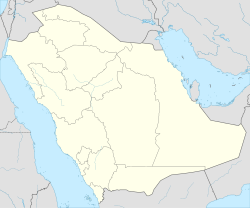Al-Kindi Plaza (Arabic: ساحة الكندي, lit. 'Al-Kindi Square'), or Al-Kindi Square,[1] is a multipurpose market square in Diplomatic Quarter, Riyadh, Saudi Arabia, located next to the Cultural Palace. Completed in 1986, it is named after the 9th century Arab philosopher and polymath Abu Yusuf al-Kindi.[2][3][4] It contains the Hayy Assafarat Grand Mosque, a library, garden, courtyard and the offices of the Royal Commission for Riyadh City and the MiSK Foundation.
Al-Kindi Plaza | |
|---|---|
| Market square | |
| Arabic: ساحة الكندي | |
 Alleyways of al-Kindi Plaza, 2013 | |
| Design | Beeah Group |
| Construction | 1981 |
| Opening date | 1986 |
| Area | 26,000 square metres (2.6 ha) |
| Dedicated to | Al-Kindi |
| Owner | Royal Commission for Riyadh City |
| Location | Diplomatic Quarter Riyadh, Saudi Arabia |
| Coordinates: 24°40′55″N 46°37′23″E / 24.68194°N 46.62306°E | |
Overview
editIn 1975, the Saudi government announced plans to relocate the headquarters of the country's foreign ministry from Jeddah to Riyadh and intended to construct a new enclave in northwest of the capital, known as the Diplomatic Quarter in order to house foreign diplomatic missions.[5]
The Al-Kindi Plaza was inaugurated in 1986 to cater the needs of the residents of Diplomatic Quarter, incorporating traditional Najdi architecture with modern materials.[6][7] In 1989, it became a recipient of the Aga Khan Award for Architecture.[8]
The market square contains a Friday mosque, which was built between 1983 and 1986,[9] triangular public square, book galleries, garden and government offices complex.[10] It is located opposite to the headquarters of the Ministry of Tourism.
The central mosque is one of the salient features of the plaza that represents the strong traditional links between religion and public services. The plaza's landscaping consists of shaded arcades, small fountains and other water elements, and planters.[11]
Modern imported technology was used to build the Al-Kindi Plaza. Reinforced concrete was used in the framed system with hollow concrete blocks for the infill; precast slabs were also used in certain parts of the building. Insulated tiled roofs and suspended ceiling complete the modern look. However, by using stucco spray on metal lath, the traditional Najdi facade of mud plaster finish on adobe (mud-brick) was preserved as a design feature. Imported marble tiles were used for flooring in the public spaces in addition to local cement.[11]
Al-Kindi Plaza usually gets crowded during weekends, religious festivities such as Eid al-Fitr, Eid al-Adha and public holidays such as Saudi National Day and Saudi Founding Day besides other organized events and celebrations.[12][13][14]
References
edit- ^ "Saudi Arabia launches Desert Truffle Festival 2022 to revive association with historic cuisine". Saudigazette. 2022-03-25. Retrieved 2023-03-30.
- ^ Architecture + Design. Media Transasia. 1990.
- ^ Architectural Record. McGraw-Hill. 1990.
- ^ Abboud, Tony (2006-01-15). Al Kindi: The Father of Arab Philosophy. The Rosen Publishing Group, Inc. ISBN 978-1-4042-0511-6.
- ^ Elsheshtawy, Yasser (2008-05-27). The Evolving Arab City: Tradition, Modernity and Urban Development. Routledge. ISBN 978-1-134-12820-4.
- ^ Salama, Ashraf M.; El-Ashmouni, Marwa M. (2020-07-15). Architectural Excellence in Islamic Societies: Distinction through the Aga Khan Award for Architecture. Routledge. ISBN 978-1-351-05747-9.
- ^ "Tuwaiq Palace: A design focused on nomadic architecture for people living on the outskirts of urban areas". Arab News. 2022-11-06. Retrieved 2023-03-29.
- ^ Petruccioli, Attilo; Pirani, Khalil K. (2013-09-13). Understanding Islamic Architecture. Routledge. ISBN 978-1-136-85131-5.
- ^ Holod, Renata; Khan, Hasan-Uddin (1997). The Contemporary Mosque: Architects, Clients, and Designs Since the 1950s. Thames and Hudson. ISBN 978-0-8478-2043-6.
- ^ Architecture, Hidden (2020-02-23). "Al-Kindi Plaza". Hidden Architecture. Retrieved 2023-03-30.
- ^ a b "Al-Kindi Plaza, Saudi Arabia (awarded 1987–1998)". Ebrary. Retrieved 2023-04-02.
- ^ "Al-Kindi Plaza, Saudi Arabia (awarded 1987–1998)". Ebrary. Retrieved 2023-04-02.
- ^ "«فنون الطهي» تنظِّم مهرجان الفقع بالرياض". www.al-jazirah.com. Retrieved 2023-04-02.
- ^ "شهد احتفال ساحات قصر الحكم وتجول في مواقع استاد فيصل بن فهد وساحة الكندي". www.al-jazirah.com. Retrieved 2023-04-02.
